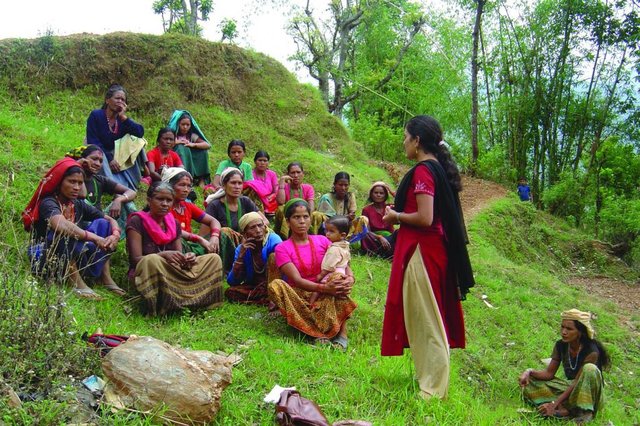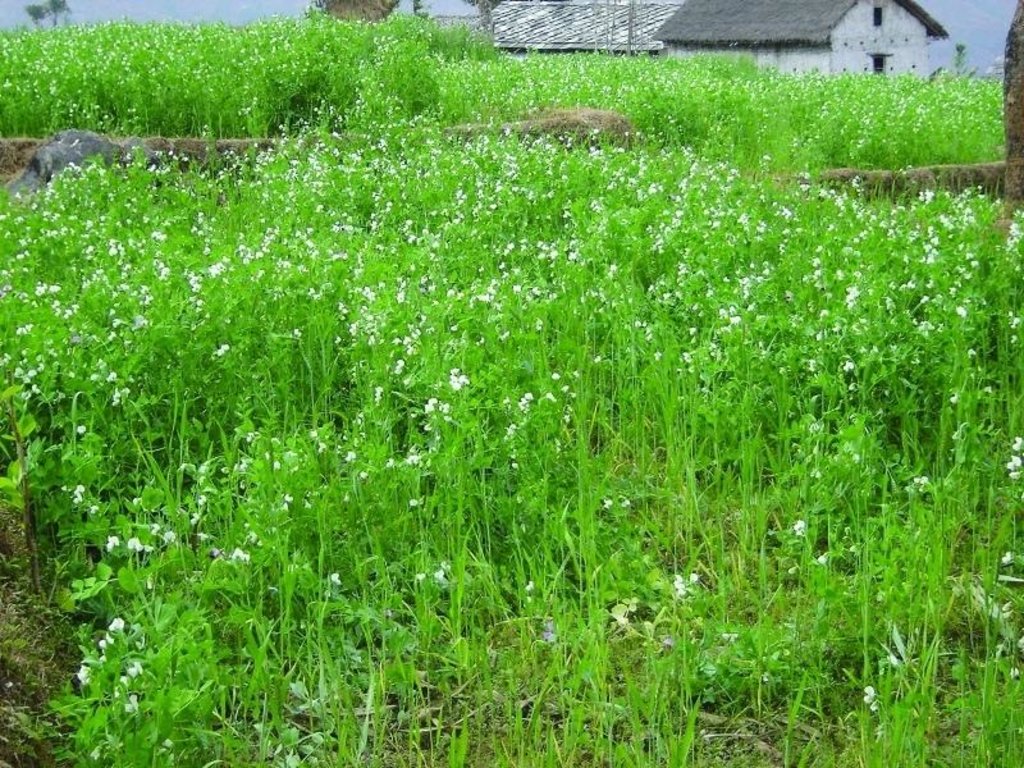Legume integration [Nepal]
- Creation:
- Update:
- Compiler: Richard Allen
- Editor: –
- Reviewers: David Streiff, Alexandra Gavilano
Bali pranali ma kosebali samabesh
technologies_1753 - Nepal
View sections
Expand all Collapse all1. General information
1.2 Contact details of resource persons and institutions involved in the assessment and documentation of the Technology
SLM specialist:
Director
Soil Management Directorate, Department of Agriculture
Nepal
SLM specialist:
Team Leader
Sustainable Soil Management Programme
Nepal
Name of project which facilitated the documentation/ evaluation of the Technology (if relevant)
Sustainable Soil Management Programme, Nepal (SSMP) {'additional_translations': {}, 'value': 682, 'label': 'Name of the institution(s) which facilitated the documentation/ evaluation of the Technology (if relevant)', 'text': 'HELVETAS (Swiss Intercooperation)', 'template': 'raw'} {'additional_translations': {}, 'value': 682, 'label': 'Name of the institution(s) which facilitated the documentation/ evaluation of the Technology (if relevant)', 'text': 'HELVETAS (Swiss Intercooperation)', 'template': 'raw'}1.3 Conditions regarding the use of data documented through WOCAT
The compiler and key resource person(s) accept the conditions regarding the use of data documented through WOCAT:
Yes
1.5 Reference to Questionnaire(s) on SLM Approaches (documented using WOCAT)

Farmer field schools on integrated plant nutrient systems [Nepal]
Participatory and collaborative learning through the farmer field school approach
- Compiler: Richard Allen

Farmer-led experimentation [Nepal]
Participatory technology testing and adaptation through farmer-led experiments
- Compiler: Richard Allen

Farmer-to-farmer diffusion [Nepal]
Wider diffusion of sustainable soil management technologies through a demand responsive farmer-to-farmer diffusion approach
- Compiler: Richard Allen
2. Description of the SLM Technology
2.1 Short description of the Technology
Definition of the Technology:
Integration of leguminous crops as intercrops on terrace risers or as relay crops
2.2 Detailed description of the Technology
Description:
Legumes are widely grown across the hills of Nepal, with the most common being soybean, lentils, black gram, cow pea, beans, horse gram, field peas, and rice bean. They are mostly intercropped or relay cropped with cereals such as maize, millet, and rice. They are also planted on the edges of terraces and rice paddy bunds. Depending on the species, they may be grown in rain-fed or irrigated fields during the winter or summer seasons.
The majority of the legumes grown by farmers are used for food or as a cash crop. The planting of fodder legumes has become more popular with the expansion of stall-feeding and the development of a dairy industry. The planting of legumes, with the main objective of improving soil fertility is a more recent development in Nepal’s hills.
Nitrogen is the main plant nutrient element and is usually applied through commercial fertiliser where available. Legumes fix atmospheric nitrogen through bacterial nodules on their roots, then nitrogen subsequently becomes available to the following crops. It is important, therefore, not to uproot the legume crop during harvesting - it should be harvested by cutting the above ground parts leaving the roots (and the nodules) in the soil. The crop residues can be fed to livestock, used as animal bedding, applied as green manure directly to fields, or incorporated in compost. In this way most of the nitrogen that was fixed by the legume crop is returned to the soil.
Details about the different legume species and their different characteristics and uses are described in detail in SSMP, PARDYP and SSD-NARC (2000).
2.3 Photos of the Technology
2.5 Country/ region/ locations where the Technology has been applied and which are covered by this assessment
Country:
Nepal
Further specification of location:
Midhills districts of Nepal
Specify the spread of the Technology:
- evenly spread over an area
Map
×3. Classification of the SLM Technology
3.1 Main purpose(s) of the Technology
- improve soil fertility
3.2 Current land use type(s) where the Technology is applied

Cropland
- Annual cropping
Comments:
Major land use problems (compiler’s opinion): Intensifying cultivation practices with either 1) inadequate application of fertilisers leading to a decline in soil fertility and the mining of soil nutrients or 2) the application of too much fertiliser causing environmental problems through excessive leaching, losses of fertiliser in surface runoff, and consequent eutrophication or nitrification of streams, ponds, or groundwater.
3.5 SLM group to which the Technology belongs
- integrated soil fertility management
- improved plant varieties/ animal breeds
3.6 SLM measures comprising the Technology

agronomic measures
- A2: Organic matter/ soil fertility
3.7 Main types of land degradation addressed by the Technology

chemical soil deterioration
- Cn: fertility decline and reduced organic matter content (not caused by erosion)
3.8 Prevention, reduction, or restoration of land degradation
Specify the goal of the Technology with regard to land degradation:
- reduce land degradation
4. Technical specifications, implementation activities, inputs, and costs
4.1 Technical drawing of the Technology
Technical specifications (related to technical drawing):
A number of species are presented
in the legume integration decision
support guide (SSMP, PARDYP, SSDNARC 2000). Here only a selection of useful legume species are presented (from top left corner to lower right corner):
- red clover (Trifolium pratense)
- hairy vetch (Vicia villosa Roth)
- Chinese milk vetch (Astragalus sinicus)
- rice bean (Vigna umbellata)
- velvet bean (Mucuna pruriens)
- tephrosia (Tephrosia spp.
Technical knowledge required for field staff / advisors: low
Technical knowledge required for land users: low
Main technical functions: increase in soil fertility (nitrogen in particular), increase in soil productivity & decrease in soil erosionon terrace bunds, nutritius and high value crops
Secondary technical functions: fodder and green manure availability & income
4.2 General information regarding the calculation of inputs and costs
Specify how costs and inputs were calculated:
- per Technology unit
Specify currency used for cost calculations:
- USD
Indicate average wage cost of hired labour per day:
2.00
4.4 Costs and inputs needed for establishment
| Specify input | Unit | Quantity | Costs per Unit | Total costs per input | % of costs borne by land users | |
|---|---|---|---|---|---|---|
| Labour | Labour | Persons/day | 2.5 | 2.0 | 5.0 | |
| Plant material | Seeds | unit | 1.0 | 1.5 | 1.5 | |
| Total costs for establishment of the Technology | 6.5 | |||||
| Total costs for establishment of the Technology in USD | 6.5 | |||||
4.5 Maintenance/ recurrent activities
| Activity | Timing/ frequency | |
|---|---|---|
| 1. | Depending on the type of farm niche - broadcast, line sow, or spot |
4.6 Costs and inputs needed for maintenance/ recurrent activities (per year)
Comments:
Cost as in January 2007
5. Natural and human environment
5.1 Climate
Annual rainfall
- < 250 mm
- 251-500 mm
- 501-750 mm
- 751-1,000 mm
- 1,001-1,500 mm
- 1,501-2,000 mm
- 2,001-3,000 mm
- 3,001-4,000 mm
- > 4,000 mm
Specifications/ comments on rainfall:
Annual rainfall: Also 2000-3000 mm
Agro-climatic zone
- humid
Thermal climate class: subtropics
5.2 Topography
Slopes on average:
- flat (0-2%)
- gentle (3-5%)
- moderate (6-10%)
- rolling (11-15%)
- hilly (16-30%)
- steep (31-60%)
- very steep (>60%)
Landforms:
- plateau/plains
- ridges
- mountain slopes
- hill slopes
- footslopes
- valley floors
Altitudinal zone:
- 0-100 m a.s.l.
- 101-500 m a.s.l.
- 501-1,000 m a.s.l.
- 1,001-1,500 m a.s.l.
- 1,501-2,000 m a.s.l.
- 2,001-2,500 m a.s.l.
- 2,501-3,000 m a.s.l.
- 3,001-4,000 m a.s.l.
- > 4,000 m a.s.l.
Comments and further specifications on topography:
Slopes on average:Also moderate (6-10%), rolling (11-15%) and hilly (16-30%)
Landforms: Also footslopes
Altitudinal zone: Also 1000-1500 m a.s.l., 1500-2000 m a.s.l. and 2000-2500 m a.s.l.
5.6 Characteristics of land users applying the Technology
Market orientation of production system:
- subsistence (self-supply)
- commercial/ market
Individuals or groups:
- individual/ household
Indicate other relevant characteristics of the land users:
Off-farm income specification: In most farm households, off-farm income plays at least a minor and increasingly a major role. Occasional opportunities for off-farm income present themselves in the form of daily labour wages. Some households’ members receive regular salaries whilst an increasing number of Nepalis are working in India, the Middle East, Malaysia and elsewhere and sending remittance incomes home.
5.7 Average area of land used by land users applying the Technology
- < 0.5 ha
- 0.5-1 ha
- 1-2 ha
- 2-5 ha
- 5-15 ha
- 15-50 ha
- 50-100 ha
- 100-500 ha
- 500-1,000 ha
- 1,000-10,000 ha
- > 10,000 ha
5.8 Land ownership, land use rights, and water use rights
Land ownership:
- individual, not titled
- individual, titled
Land use rights:
- leased
- individual
Comments:
sharecropping between owner and tenant
6. Impacts and concluding statements
6.1 On-site impacts the Technology has shown
Socio-economic impacts
Income and costs
expenses on agricultural inputs
Comments/ specify:
Reduced expenses for nitrogen fertilizers
Other socio-economic impacts
Livestock fodder nutritiousness
Value and nutritiousness of crops
Crop in terms of main yield
Ecological impacts
Soil
soil loss
soil organic matter/ below ground C
Biodiversity: vegetation, animals
pest/ disease control
Comments/ specify:
Highly susceptible to diseases and pests
Other ecological impacts
Application of fertilizer
6.2 Off-site impacts the Technology has shown
groundwater/ river pollution
Comments/ specify:
Reduced nutrient flux into water bodies
Dependence on outside
6.4 Cost-benefit analysis
How do the benefits compare with the establishment costs (from land users’ perspective)?
Short-term returns:
positive
Long-term returns:
positive
How do the benefits compare with the maintenance/ recurrent costs (from land users' perspective)?
Short-term returns:
positive
Long-term returns:
positive
Comments:
On average a benefi t of US$ 40 to 50 per ropani can be expected from the production of legume species
6.5 Adoption of the Technology
Comments:
Comments on spontaneous adoption: About 80% of participating farmers used/had adopted the technolog. It has also been adopted by farmers who have not directly participated in SSMP activities.
6.7 Strengths/ advantages/ opportunities of the Technology
| Strengths/ advantages/ opportunities in the compiler’s or other key resource person’s view |
|---|
| Cost effective in terms of inputs and management practices in comparison with other commodities |
| Needs less agronomic practices and care (i.e. can be cultivated in zero or reduced tillage) |
| Has multiple uses: food crop, feed crop, fodder, soil building |
| Can be integrated in varying niches on farms and therefore does not need additional land |
| Rich indigenous knowledge exists |
6.8 Weaknesses/ disadvantages/ risks of the Technology and ways of overcoming them
| Weaknesses/ disadvantages/ risks in the compiler’s or other key resource person’s view | How can they be overcome? |
|---|---|
| Highly vulnerable to diseases and pests | Skip planting time (i.e. preponing planting of crops to get around life cycle of pests) , use location specifi c species, resistant varieties |
| Very susceptible to waterlogging | Only plant in well-drained soils |
| In high fertility conditions, nitrogen fixing rhizobium does not work leading to less nitrogen fixation | For very specifi c and new species, the soil needs to be inoculated with the correct strain of bacteria |
| Legumes generally do not respond to nitrogen fertiliser | Do not apply nitrogen fertiliser to legumes |
7. References and links
7.1 Methods/ sources of information
7.2 References to available publications
Title, author, year, ISBN:
SSMP (2005) Legume Integration Manual (in Nepali). Kathmandu: Sustainable Soil Management Programme
Available from where? Costs?
SSMP
Title, author, year, ISBN:
SSMP; PARDYP; SSD-NARC (2000) LegumeIntegration into Hill Farming Systems, Decision Support Guide Kathmandu: Sustainable Soil Management Programme, People and Resource Dynamics Project and Soil Science Division-Nepal Agricultural Research Council
Available from where? Costs?
SSMP
Links and modules
Expand all Collapse allLinks

Farmer field schools on integrated plant nutrient systems [Nepal]
Participatory and collaborative learning through the farmer field school approach
- Compiler: Richard Allen

Farmer-led experimentation [Nepal]
Participatory technology testing and adaptation through farmer-led experiments
- Compiler: Richard Allen

Farmer-to-farmer diffusion [Nepal]
Wider diffusion of sustainable soil management technologies through a demand responsive farmer-to-farmer diffusion approach
- Compiler: Richard Allen
Modules
No modules




